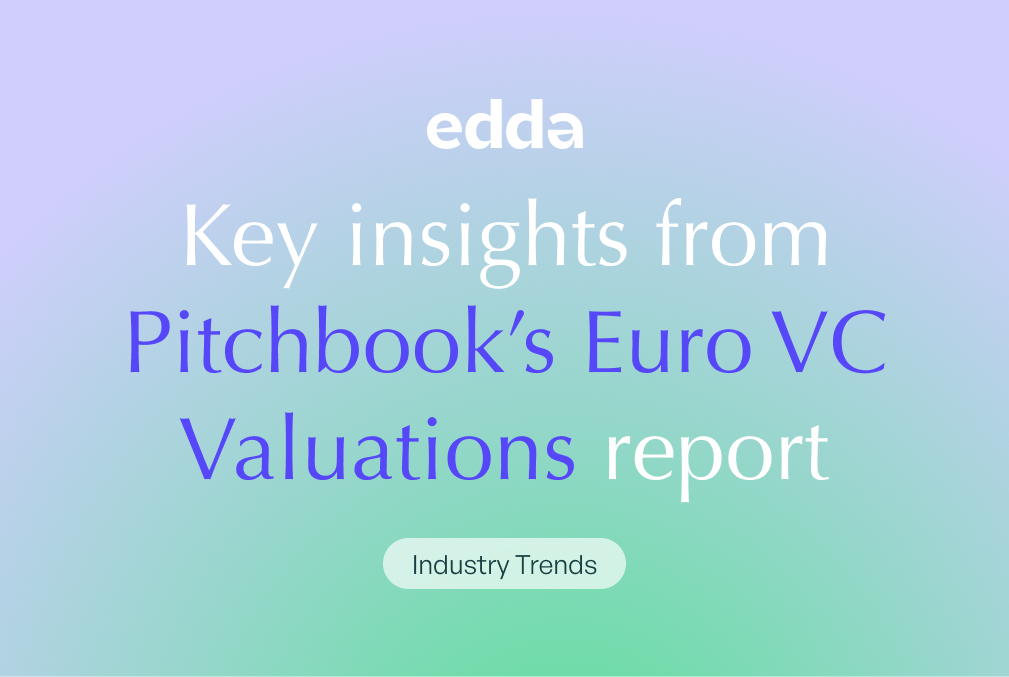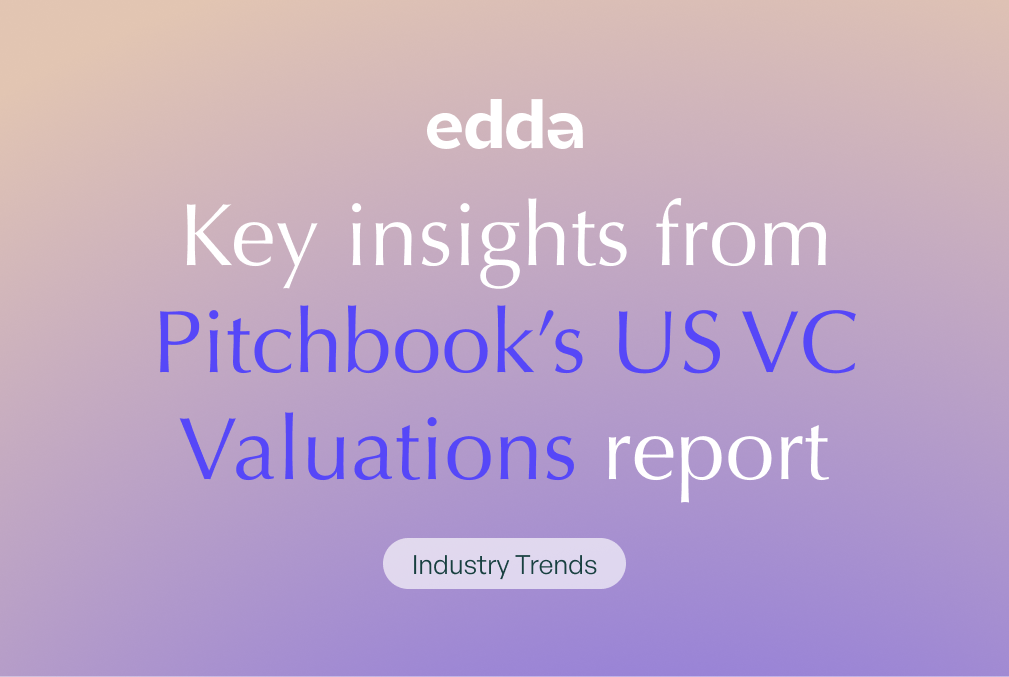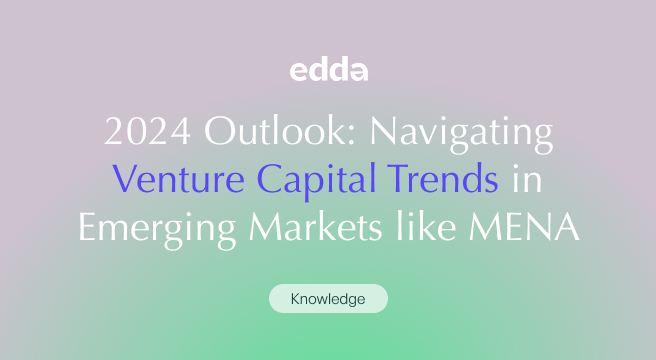PitchBook’s Q2 2024 Euro VC Valuations Report unpacks the changing dynamics of European venture capital, revealing how shifting valuations and the rising influence of nontraditional investors are reshaping the market. As the environment changes, VCs need to stay sharp to seize the best opportunities with comprehensive software venture capital tools.
This article breaks down the report’s most important insights, offering a clear view of where the European market is heading. Whether you’re deep in deal-making or planning your next exit, understanding these trends will keep you ahead of the curve. Plus, explore how Edda’s HERA.I, with its AI-driven venture capital management software, can help you stay nimble, manage your portfolio with ease, and keep your competitive edge as market tides turn.
Valuation Trends by Stage
How have valuations & deal sizes changed across different stages of VC funding in 2024?
In the first half of 2024, pre-seed valuations jumped by 57%, from €2.8 million in 2023 to €4.4 million by Q2, signaling strong investor confidence in early-stage startups, especially in high-growth areas like AI and fintech.
Despite this boost in valuations, pre-seed deal sizes stayed steady at a median of €0.6 million. This stability suggests that while investors are optimistic, they’re still cautious about how much they commit early on, preferring to spread their investments across multiple startups due to the risks involved.
Early-stage VC deals saw significant growth, with median deal sizes climbing by nearly 44% to €1.8 million. This shows that VCs are willing to invest more money earlier in the startup journey, particularly in sectors that promise rapid growth. It reflects growing confidence in startups that have moved past the idea stage and are starting to gain real traction in the market.
In the late-stage VC space, valuations dipped slightly by 2.8% to €10.8 million, but deal sizes increased significantly by 33.3%, reaching €4.0 million. This indicates that while investors may be a bit more cautious with valuations, they’re still ready to make larger bets on companies that have shown strong growth and are ready to scale further.
The venture growth stage saw the biggest jump in deal sizes, rising from €6.0 million in 2023 to €8.2 million in H1 2024. Although valuations in this stage remained mostly steady with a slight decrease, the larger deal sizes underscore strong investor interest in supporting companies with solid business models that are poised for rapid expansion.
How does the time between funding rounds vary across stages?
The time between funding rounds, known as funding cadence, varies depending on the stage of the startup. At the pre-seed stage, rounds happen fairly quickly, typically around 0.9 years apart. This fast pace is driven by the urgent need for early-stage startups to secure more capital to develop their products and gain initial market traction, especially given the high risks and uncertainties they face.
As startups progress to the seed stage, the gap between rounds extends to about 1.5 years. This longer period allows startups to refine their products, build a customer base, and prove their business model. Similarly, in the early-stage VC segment, companies usually experience about 1.5 years between rounds, giving them time to scale operations, grow their teams, and strengthen their market position before seeking additional capital.
In late-stage VC, the time between rounds lengthens further to around 2.1 years. At this stage, startups are more mature, with steady revenue streams and a clearer path to profitability or an exit. The longer interval reflects the complexities of scaling, such as expanding internationally, developing new products, or preparing for an exit.
For companies in the venture growth stage, the time between rounds stays at roughly 1.5 years. This period is driven by the need for aggressive growth and market expansion, with companies requiring regular infusions of capital to keep up their momentum.
Sector-Specific Trends
Which sectors are seeing the most significant growth in valuations?
In the first half of 2024, AI and Machine Learning (AI & ML) continued to be a magnet for investors, with early-stage companies in this space securing some of the largest deal sizes. VCs are particularly excited about AI’s rapid advancements and its potential to transform industries and create new markets altogether.
Fintech also remained a hot sector, with companies like Monzo, Revolut, and Starling Bank achieving impressive valuations. The sector’s growth is fueled by constant innovation in digital banking, payments, and financial services, along with the growing use of blockchain and AI technologies. These developments have reinforced market confidence as fintech companies are set to reshape global financial services.
Cleantech saw a strong comeback, with rising valuations driven by global commitments to sustainability and renewable energy. Investors are increasingly drawn to companies that offer innovative solutions to environmental challenges, reflecting a strong belief in cleantech’s long-term potential, backed by supportive regulations and shifting consumer preferences.
The SaaS sector, while not as explosive as AI or fintech, maintained steady growth, with early-stage deal sizes averaging €2.2 million. SaaS continues to be a reliable investment due to its scalable business models and recurring revenue streams. The ongoing demand for cloud-based solutions across various industries keeps this sector appealing to VCs.
LOHAS (Lifestyles of Health and Sustainability) also saw solid performance, with early-stage deal sizes around €1.5 million. The sector’s growth is being driven by increasing consumer demand for products and services that promote well-being and environmental responsibility. While it might not grab headlines like the tech sectors, LOHAS presents strong growth opportunities for investors focused on health and sustainability.
Regional Insights
Which regions are leading in terms of deal size and valuation growth?
In H1 2024, Israel continues to dominate in early-stage deal sizes, with a median of €12.5 million. This reflects Israel’s stronghold in high-tech areas such as cybersecurity, AI, and healthtech. The country’s deep focus on cutting-edge technology and its reputation as an innovation hub attract significant VC investment, fueling both deal sizes and valuation growth.
The Nordics are also leading, particularly in fintech, cleantech, and AI. Early-stage valuations in the region hit a median of €6.8 million, driven by a strong emphasis on sustainability and tech innovation. The region’s supportive economic climate and focus on forward-thinking industries contribute to its high valuations and substantial deal sizes.
In the DACH region (Germany, Austria, Switzerland), late-stage VC deals stood out, with a median deal size reaching €10.0 million by the end of H1 2024. The area benefits from a strong industrial base, a healthy economy, and significant government backing for innovation, all of which contribute to large deal sizes and growing valuations.
The UK & Ireland remain pivotal players in the European VC scene, particularly in fintech and AI. While early-stage valuations are more moderate, the overall volume of investments and the presence of well-established, high-value companies drive strong valuation growth, especially in later stages. The UK’s status as a global financial center, paired with a vibrant tech sector, ensures it remains a key region for major VC deals.
Southern Europe typically lags in early-stage valuations, with a median of €1.2 million. However, there’s significant growth in late-stage deals, where valuations reached €10.6 million. This indicates that while the region may not be as appealing for early-stage investments, it is increasingly seen as a promising area for scaling mature startups, particularly in sectors like tourism, agritech, and renewable energy.
What regional factors are influencing VC investments in Europe?
In H1 2024, economic Stability played a key role, with regions like the Nordics and DACH (Germany, Austria, Switzerland) attracting significant VC investments due to their dependable economies, well-developed infrastructure, and supportive government frameworks. These regions provide a solid ground for startups to scale, leading to higher valuations and presenting fewer risks for investors.
Sector Focus also influenced investment patterns, as different regions have developed strong expertise in particular industries. For instance, the Nordics excel in fintech, cleantech, and AI, while Israel is renowned for cybersecurity and healthtech. This allows VCs to channel their investments into regions that align with their industry interests, resulting in more targeted and potentially rewarding deals.
Government Incentives are another important factor, with regions like Ireland and Israel offering favorable tax regimes, startup grants, and research and development incentives. These measures help reduce financial risks for investors and encourage the growth of local startups, making these regions especially appealing for venture capital.
Market Size and Accessibility are significant considerations, with larger markets such as the UK and Germany naturally drawing more VC interest due to their expansive consumer bases and easier access to capital. These markets are attractive for both early and late-stage investments due to their potential for rapid growth. Conversely, smaller markets in Central & Eastern Europe might attract less investment due to perceived market constraints, although they still capture attention in niche or fast-growing sectors.
The Cultural and Business Climate also impacts VC decisions, with regions like Israel and the UK standing out for their vibrant entrepreneurial culture, experienced founders, and strong support networks. These factors foster innovation and increase the chances of successful exits, making these regions more attractive for venture capital.
Nontraditional Investor Impact
How are nontraditional investors influencing the VC market in 2024?
In the first half of 2024, nontraditional investors (NTIs) like corporate venture capital (CVC), private equity firms, and hedge funds became even more influential in the European VC scene. These investors were involved in 39.4% of all VC deals and accounted for a hefty 76.3% of the total deal value. Their focus on larger, well-established companies stresses their growing role in scaling businesses and driving significant deal sizes.
NTIs were particularly drawn to high-growth sectors like cleantech and crypto, where their investments pushed valuations higher. Cleantech attracted these investors due to its alignment with global sustainability goals and the promise of long-term returns. Meanwhile, the disruptive potential and rapid advancements in blockchain technology made the crypto sector a magnet for NTIs.
Typically, when NTIs get involved, deal sizes and valuations tend to be larger, with CVC-backed deals often seeing valuations two to three times higher than those without their involvement. This shows that NTIs aren’t just passive backers; they are actively shaping the VC arena by pushing for bigger, more impactful investments.
Beyond just financial returns, many NTIs, particularly CVCs, invest with strategic goals in mind—whether it’s tapping into new technologies, entering new markets, or building industry partnerships. This approach gives startups access to valuable resources, networks, and expertise, which can significantly speed up their growth.
Unicorn Activity
What are the current trends in unicorn valuations and financing rounds?
In H1 2024, the median deal size for unicorns slightly dipped to €98.7 million from €120.1 million in 2023. This reduction indicates that while unicorns still draw substantial investments, investors are becoming more careful, focusing on ensuring that valuations reflect the company’s real performance and growth potential.
Despite this drop in deal size, the number of unicorn deals increased, with 28 transactions completed by mid-2024, compared to 39 throughout 2023. This rise shows that investors are still keen to back promising companies, though they are being more measured in the amounts they invest. The unicorn market remains vibrant, with VCs actively looking for opportunities in companies that have demonstrated strong growth.
Unicorns are also returning to the funding market more frequently than before. This quicker pace is driven by the ongoing need for growth capital, efforts to bolster financial stability in a volatile environment, and the push to stay competitive in rapidly evolving sectors like AI and fintech. The faster return to the market reflects the continuous demand for funding to fuel expansion, particularly in dynamic industries.
While unicorns continue to command high valuations, there is a clear trend towards more careful and realistic valuation practices. Investors are paying closer attention to the financial health and market prospects of these companies before committing significant capital, likely due to concerns about market fluctuations and the sustainability of past high-growth expectations.
How are unicorns performing in terms of their time to market & exit strategies?
In H1 2024, many unicorns are delaying exits like IPOs or acquisitions, opting to stay private longer to bolster their financial positions in response to market volatility.
This patient approach is designed to maximize valuations before stepping into public markets or negotiating deals. There is a noticeable shift toward acquisitions as the preferred exit route, especially in sectors like fintech and healthtech, where acquisitions offer a quicker and more predictable outcome compared to the uncertain path of an IPO.
Unicorns are also increasingly focused on strategic positioning for optimal exits. This includes expanding into new markets, acquiring complementary technologies, and strengthening leadership teams to enhance their appeal to potential acquirers or public investors.
The broader economic environment continues to play a significant role, with ongoing uncertainty leading many unicorns to delay exits in hopes of more favorable conditions. This cautious stance is reflected in the steady and deliberate pace of funding rounds, where long-term growth is prioritized over immediate liquidity.
What does the changing ratio of unicorn value to IPO value indicate about the market?
In 2024, the shifting relationship between unicorn valuations in private markets and their values at IPO highlights some important trends. The gap between these valuations has been getting smaller, indicating that both investors and markets are adopting a more cautious and realistic approach.
This shift suggests that valuations are increasingly being tied to actual business performance and profitability, rather than just future growth potential. As the venture capital market matures, investors are paying more attention to solid financial metrics like revenue, profitability, and market share, rather than just banking on ambitious growth projections.
For unicorns, this narrowing gap means that moving from private to public markets might be less bumpy, with fewer dramatic valuation drops when they go public. However, it also means that these companies will need to prove they deserve their private valuations when they make the jump to an IPO.
This closer alignment between private and public valuations reduces the chances of disappointing IPO results, but it also raises the bar for what is considered a “successful” IPO. Overall, the trend reflects a broader change in investor attitudes, with a growing focus on sustainable growth rather than rapid expansion without clear profitability.
Liquidity & Exit Trends
What exit strategies are most common for VC-backed companies in 2024?
In 2024, acquisitions remain the top choice, accounting for most exits in H1 2024, with median valuations up 35.5% to €33.9 million. Larger companies are keen to acquire innovative startups to access new technologies, expand their offerings, or break into new markets. For startups, acquisitions provide a quicker and more predictable exit compared to navigating an IPO, especially in a volatile market.
IPOs are still on the table but have become less common due to ongoing market instability. The median valuation for IPOs dropped by 29.1% to €11.3 million in H1 2024, as companies opt to delay going public until conditions improve. This has led to a greater reliance on alternative exits like acquisitions.
Buyouts are also gaining popularity, particularly among later-stage companies looking to avoid the uncertainties of public markets. Private equity buyouts offer a way to achieve liquidity while staying private, with additional capital to fuel growth, especially in sectors like healthcare and technology where innovation demands significant investment.
Secondary Sales are on the rise as well, allowing early investors or founders to sell shares to new investors through private transactions. This option provides liquidity without requiring the company to go public or be acquired, becoming more common as the time to exit extends.
How are exit valuations trending, and what factors are influencing them?
In the second half of 2024, exit valuations are expected to continue their upward trajectory, particularly for acquisitions, even amid economic uncertainty. This positive outlook is driven by several key factors:
Anticipated interest rate cuts and improving economic indicators are likely to create a more favorable environment for exits, with larger companies continuing to acquire innovative startups to bolster their growth, pushing exit valuations higher.
The narrowing gap between private and public market valuations, observed earlier in the year, is also expected to contribute to higher exit valuations. This closer alignment means that startups are more likely to meet investor expectations during exits, reducing the risk of significant valuation drops.
There is strong and ongoing demand for strategic acquisitions, particularly in high-growth sectors like fintech, AI, and cleantech. As corporations seek growth through acquisitions, competition for quality startups is likely to push valuations even higher, especially in industries where rapid innovation offers a competitive edge.
While IPO activity has been subdued, there is cautious optimism that conditions might improve in the latter half of 2024. If market volatility eases, we could see a modest increase in IPOs, with valuations more closely aligned with private market levels.
However, IPOs are still expected to lag behind acquisitions in terms of both frequency and valuation growth. Additionally, private equity firms are likely to support higher exit valuations through buyouts, as they continue to invest heavily in later-stage companies, offering a strong alternative to public market exits.
Optimize Your VC Strategy with Edda’s HERA.I
The Q2 2024 European VC Valuations Report makes it clear: the VC market is constantly in flux, and staying competitive requires more than just intuition—it demands precision and efficiency.
Edda’s venture capital portfolio management software and HERA.I platform is designed to give you that edge. This AI-driven tool combines deal flow management, portfolio tracking, and investor relations into one seamless experience. With Edda’s venture capital CRM and HERA.I, you can streamline your operations, making it easier to spot opportunities, manage investments, and make decisions that are backed by real data.
If you’re serious about staying ahead of the curve and capitalizing on the trends highlighted in the report, HERA.I is the tool you need. It empowers you to handle complex exits, scale large deals, and optimize your portfolio with confidence.
Don’t get caught off guard. Equip yourself with Edda’s venture capital software and turn market insights into actionable strategies that keep you ahead of the competition.













